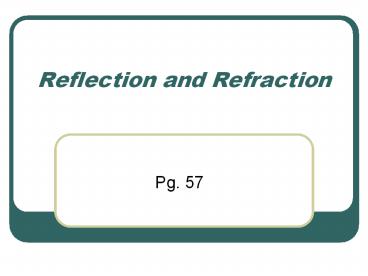Reflection and Refraction PowerPoint PPT Presentation
Title: Reflection and Refraction
1
Reflection and Refraction
- Pg. 57
2
Reflection of light
- Can be modeled as a light ray
- We can trace the path of light in ray diagrams
- Angle of reflectionangle of incidence
- i r
- This equality is called the law of reflection
3
Calculating angle of reflection
- The angle of incidence and the angle of
reflection are measured from a line that is
perpendicular to the surface. - This line is called the normal.
4
Measuring the angle of reflection
- Draw the normal by placing your protractor on the
point where the light ray hits the surface. - Measure the angle of incidence
- Draw a line equal to the angle of incidence going
the opposite direction.
5
(No Transcript)
6
Mirrors
- Mirrors form virtual images.
- Curved mirrors distort images.
- Mirrors that bulge are called convex mirrors.
- Convex mirrors -make images appear smaller than
they actually are. - Indented mirrors are called concave mirrors.
- Concave mirrors magnify objects.
7
Colors
- An objects color is the color that is reflected.
- The wavelength of the color is reflected into
your eyes while the other colors are absorbed by
the object. - Mixing light of the 3 primary colors (red, green,
and blue) creates white light. - Secondary colors are made by mixing two primary
colors. - If the three primary colors are combined, all
visible light is absorbed so you see black. - Black is not a color, it is the absence of color.
8
(No Transcript)
9
Refraction of light
- Refraction makes objects appear to be in a
different position - The angle of refraction can be calculated
- The angle of refraction is also called the index
of refraction
10
Measuring the angle of refraction
- Draw the normal line perpendicular to the point
where the light ray hits the surface. - Connect the two lines
- Measure the angle of incidence
- Measure the angle of refraction (angle between
the normal and drawn line)
11
Measuring the angle of refraction
12
Lenses
- Lens-a transparent object that refracts light
waves so they converge or diverge. - Converging lens bends inward.
- Diverging lens bends outward.
- Lenses magnify objects.
13
Lenses for magnification
- Magnification is any change in the size of an
image compared to the object. - The focal point of a light ray is made when you
can focus light rays into a small area.
14
The eye
- The eye uses refraction of light to see.
- Light enters the cornea. It then passes through
the pupil. The light then reaches the lens where
it can be curved to focus an image on the retina.
- The retina is composed of rods and cones. The
cones are responsible for color vision.
15
Dispersion and prisms
- Prism-a transparent solid that consists of two
planes that are at an angle with each other. - Dispersion-when light separates into different
colors because of differences in wave speed. - Rainbows are caused by dispersion.

